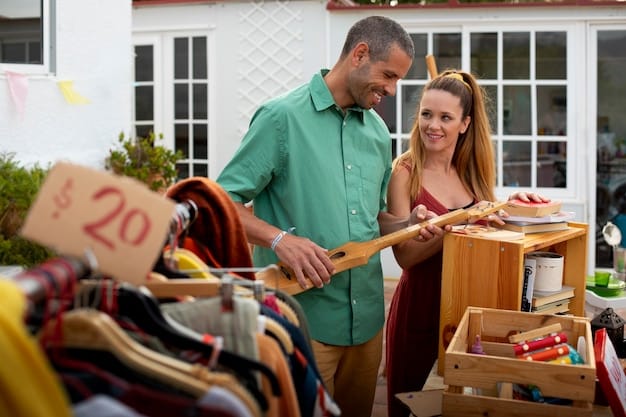Negotiate Prices at Flea Markets: Fashion Finds on a Budget

Negotiating prices at flea markets is an art that, when mastered, allows savvy shoppers to score amazing fashion finds while staying within a budget, turning thrifting into a stylish and affordable adventure.
Discover how to negotiate prices at flea markets and score amazing fashion finds without breaking the bank. Learn the secrets to thrifting like a pro and building a stylish, budget-friendly wardrobe.
Mastering the Art of Flea Market Negotiation for Fashion Finds
Flea markets are treasure troves of unique fashion items, from vintage dresses to handcrafted accessories. However, the marked prices aren’t always set in stone. Knowing how to negotiate effectively can significantly reduce the cost of your purchases, allowing you to expand your wardrobe while sticking to your budget.
This guide explores the strategies and tactics you need to become a skilled negotiator at flea markets, transforming your thrifting experience and helping you uncover incredible fashion deals.
Understanding the Flea Market Environment
Before diving into negotiation tactics, it’s essential to understand the dynamics of a flea market. Vendors often have varying motivations, from clearing out old inventory to making a living. Recognizing their perspective can give you an edge in your negotiations.
- Seasonal Fluctuations: Prices may fluctuate depending on the season and location of the flea market.
- Vendor Goals: Some vendors are more eager to sell than others, depending on their inventory and personal circumstances.
- Market Research: Take time to research typical prices for similar items, so you have a benchmark for negotiating.
A successful negotiation starts with understanding the seller’s position and the environment in which they operate. This knowledge will help you tailor your approach and increase your chances of getting a better price.

Building Rapport and Setting the Stage for Negotiation
Establishing a positive relationship with the vendor is crucial for successful negotiation. A friendly and respectful approach can go a long way, creating an atmosphere of collaboration rather than confrontation.
The key is to be genuine, show interest in their items, and treat them with respect. This builds trust and makes them more willing to consider your offer.
Starting with a Friendly Approach
Engage the vendor in a polite and friendly manner. Ask about the item, express your admiration, and show genuine interest in their offerings. A simple “Hello, how are you today?” can set a positive tone.
- Be Approachable: Smile, make eye contact, and use a friendly tone of voice.
- Show Interest: Ask questions about the item’s history or origin.
- Offer Compliments: Compliment their selection or the specific item you’re interested in.
Building rapport with the vendor creates a more conducive environment for negotiation. They are more likely to be open to your offer if they perceive you as a friendly and respectful customer.
Building a connection with the vendor will set the stage for a more favorable negotiation. People are more inclined to help someone they like, so take the time to establish a friendly relationship.
Tactics for Negotiating Prices Effectively
Once you’ve established a positive rapport, it’s time to start negotiating. There are several tactics you can use to lower the price, but it’s important to be respectful and avoid being pushy or aggressive.
A strategic approach, combined with a friendly demeanor, can help you achieve the desired price without offending the vendor.
The Art of Making an Offer
Making the first offer can be a powerful tactic if done correctly. Start with a lower price than you’re willing to pay, but not so low that it’s insulting. Be prepared to explain why you’re offering that price.
Be reasonable, explain why your offer is fair, and be ready to negotiate upwards. Most vendors expect negotiation, so don’t be afraid to make a counteroffer.
Highlighting Flaws (Tactfully)
If the item has any minor flaws, such as a small stain or a loose button, gently point them out. This can justify your lower offer without being overly critical. However, avoid exaggerating the flaws or being disrespectful.
- Be Gentle: Point out flaws in a non-judgmental way.
- Focus on Repairability: Mention that you’ll need to invest time and money to fix the flaw.
- Be Realistic: Don’t expect a major discount for a minor imperfection.
By tactfully highlighting flaws, you can justify your offer without appearing overly critical. This approach shows the vendor that you’ve carefully assessed the item and are making a reasonable offer.
Bundling Items for a Better Deal
If you’re interested in multiple items, consider bundling them together. Vendors are often more willing to offer a discount if you’re buying more than one item. This saves them time and effort, making them more amenable to negotiation.
Buying multiple items from a single vendor can lead to significant savings. Most vendors appreciate a bulk sale and are often open to reducing the overall price.

Timing and Patience: Key Elements in Flea Market Bargaining
The timing of your negotiation can significantly impact its success. Vendors are often more willing to negotiate at the end of the day when they are eager to make sales before packing up. Patience is also crucial; don’t rush the process.
Knowing when to make your move and being prepared to walk away can give you a significant advantage in getting the best possible price.
End-of-Day Advantages
Vendors are typically more motivated to sell at the end of the day to avoid packing up unsold items. This is an ideal time to make your offer, as they may be more flexible with their prices. Be polite and understanding, as they may be tired from a long day.
- Observe the Crowd: Notice if the vendor has had a busy or slow day.
- Offer a Fair Price: Be respectful and avoid lowballing, even at the end of the day.
- Be Prepared to Buy: If they accept your offer, be ready to complete the purchase.
Taking advantage of the end-of-day situation can lead to significant savings. Vendors are often more willing to negotiate to avoid the hassle of packing and storing unsold items.
The Power of Walking Away
Sometimes, the best negotiation tactic is to walk away. If the vendor is unwilling to meet your price, politely thank them and start to leave. Often, they will call you back with a counteroffer rather than lose a potential sale. However, be prepared to actually walk away if they don’t budge.
The willingness to walk away is a powerful tool. It shows the vendor that you’re serious about your offer and are not afraid to look elsewhere.
Common Mistakes to Avoid During Negotiation
While negotiation can be a fun and rewarding experience, it’s important to avoid common mistakes that can damage your chances of getting a good deal. These include being overly aggressive, lowballing, and failing to do your research.
Being aware of these pitfalls and taking steps to avoid them can help you maintain a positive relationship with the vendor and achieve your desired price.
Being Disrespectful or Aggressive
Never be disrespectful or aggressive during negotiation. This will immediately put the vendor on the defensive and make them less likely to negotiate with you. Always maintain a polite and friendly demeanor, even if you disagree on the price.
- Use Polite Language: Always say “please” and “thank you.”
- Avoid Arguing: If you disagree, express your opinion respectfully.
- Be Empathetic: Understand that the vendor is trying to make a living.
Maintaining a respectful and friendly attitude is crucial for successful negotiation. Your goal is to create a collaborative environment, not a confrontational one.
Failing to Research Prices
Before heading to the flea market, take the time to research the typical prices for the items you’re interested in. This will give you a benchmark for negotiation and prevent you from overpaying. Check online marketplaces, antique stores, and other sources to get an idea of the item’s value.
Price research is essential for effective negotiation. Knowing the value of the item allows you to make informed offers and avoid being taken advantage of.
Final Tips for Thrifting Success at Flea Markets
Besides negotiation tactics, there are several other tips that can enhance your thrifting experience and help you score amazing fashion finds at flea markets. These include arriving early, dressing comfortably, and bringing cash.
Attention to detail and careful preparation can greatly improve your chances of finding unique and affordable fashion items.
Arrive Early for the Best Selection
Arriving early at the flea market gives you access to the best selection of items. Vendors are often still setting up, and you’ll have the opportunity to browse before the crowds arrive. This also allows you to take your time and carefully inspect the items before making an offer.
- Plan Ahead: Check the flea market’s opening hours and plan to arrive shortly after it opens.
- Be Patient: Vendors may still be unpacking, so be respectful and give them space.
- Bring a List: Having a list of items you’re looking for can help you stay focused.
Early arrival is key to finding the best fashion treasures. You will find the earliest and greatest offers too.
Cash is King (and Often Gets a Discount)
Many vendors prefer cash payments, and some may offer a discount if you pay in cash. This is because they avoid credit card processing fees. Be sure to bring plenty of small bills and coins to make transactions easier. Not everyone accepts credit cards, so carry both.
Paying with cash can be a great way to save money at flea markets. Vendors often appreciate cash payments and may be willing to lower the price.
| Key Point | Brief Description |
|---|---|
| 🤝 Building Rapport | Engage vendors with a friendly and respectful approach. |
| 💰 Making Offers | Start with a fair offer, considering any flaws. |
| 🛒 Bundling Items | Buy multiple items from one vendor to get a better deal. |
| 🚶 The “Walk Away” | Be willing to walk away if the price isn’t right. |
Frequently Asked Questions (FAQ)
▼
The best time is late in the day, as vendors are often more willing to lower prices to avoid packing up unsold items. However, arriving early can provide a wider selection.
▼
Start about 20-30% lower than the asking price, but be prepared to negotiate upwards. Your offer should reflect the item’s condition and market value.
▼
It’s not rude if done tactfully. Gently mentioning minor imperfections can justify your lower price, but avoid being overly critical or exaggerating flaws.
▼
Politely thank them and be prepared to walk away. Sometimes, they might call you back with a counteroffer. If they don’t, it might be best to find a similar item elsewhere.
▼
While not universal, most vendors do prefer cash, and paying with cash sometimes gets you a discount, as it helps them avoid credit card processing fees. It is always a recommended method of purchase for this reason.
Conclusion
Mastering the art of negotiation at flea markets can be both rewarding and budget-friendly. By building rapport, employing smart strategies, and avoiding common pitfalls, you can score amazing fashion finds without overspending. Remember to be patient, friendly, and always respect the vendor’s position, and you’ll be well on your way to becoming a thrifting pro.





